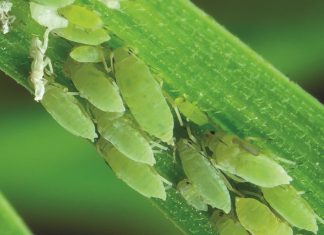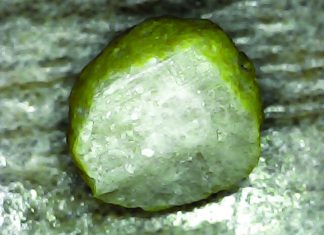
 Owen Rhode,
Owen Rhode, ARC-Grain Crops
Maize production in Southern Africa occurs commercially on large farms as well as on more than 12 000 smaller farms, primarily in the North-West Province, Mpumalanga, the Free State and KwaZulu-Natal.
The relatively higher and stable returns obtained from maize when compared to that of alternative crops, the relative ease with which it can be produced and the high efficacy of pesticides and herbicides to control pests and weeds on maize, all contributed to a maize monocropping practice. The production of maize, however, can be influenced by various abiotic and biotic factors. Monocropping often goes hand in hand with poor soil fertility in combination with nutrient imbalances. To complicate matters further, most of the soils in Southern Africa have a low amount of phosphorus (P) available to the plant. Producers therefore depend heavily on chemical P fertiliser to supplement low soil P.
Elevated levels of chemical P application can lead to poor plant growth because it reduces the plant’s ability to take up essential micronutrients, mainly iron and zinc, even when adequately available. On the other hand, excessive chemical nitrogen (N) can increase a plant’s susceptibility to pests and fungal diseases and promote vegetative growth at the expense of yield. Leached N, particularly on sandy soils, can pollute rivers and streams, posing a significant risk to marine animals and livestock dependent on it as a water source.
The inclusion of legumes in a maize-based crop rotation system generally improves maize production. In addition, the improvement and nourishment of enzyme activity through judicious cropping (Photo 1) and tillage systems, have the potential to reduce the use of chemical fertiliser and provide plants with a more readily available nutrient basis in more balanced proportions. Soil enzymes are involved in many important soil processes, such as the breakdown of soil organic matter (SOM) that is then released into the soil during plant growth as well as the release of mineral nutrients and aid in its supply to plants.
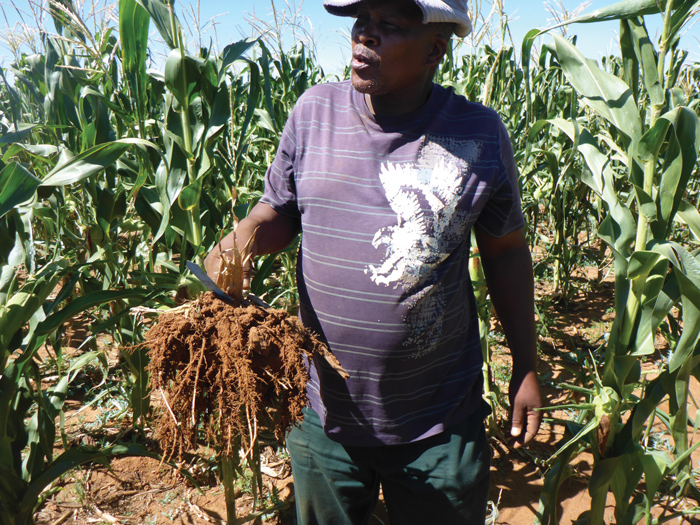
Enzymes such as β-glucosidase are involved with carbon cycling, which is important because carbon is the main component of SOM and it helps give soil its water-retention capacity, structure, and fertility. Urease enzymes help to degrade urea to promote N availability to the plant. Phosphatase enzymes change unavailable forms of organic P into phosphate that can be absorbed by plants. Enzyme activity is, therefore, affected by soil environmental changes, cropping or farming systems and fertilisation. Urease is influenced by the cropping system, SOM, tillage, as well as pH. Monitoring soil enzyme activity is important in order to understand the farming systems that regulate it.
Legumes such as cowpea and soybean included in such a maize-based crop rotation system can either be used for human consumption or for animal feed. The contributions of grain legumes to N availability have been well documented, but the non-N effects of cowpea and soybean, including the impacts on soil enzyme activities because of the quality and quantity of the organic compounds released by their roots (root exudates) into the rhizosphere of the plant roots, needed to be studied.
Method
The study was conducted over two consecutive growing seasons at Lichtenburg to investigate the impact of cowpea-maize and soybean-maize rotation on soil enzyme activity compared to that in continuous maize under high (to achieve a 4 t/ha maize grain yield) and low (half of the fertiliser used in the high level) fertilisation levels, respectively. Crop cultivars used in this study included BG 5685R (maize), Bechuana white (cowpea) and PHB 96T06R (soybean). The trial site consisted of an Avalon soil form with sandy loam texture and had an average annual rainfall of about 580 mm. The soil enzymes monitored included β-glucosidase, alkaline phosphatase and urease. Soil sampling of the trials for enzyme analysis was done at flowering stage, because this is when roots are actively growing and thus fuelling enzyme activity via derived organic materials (Photo 2).
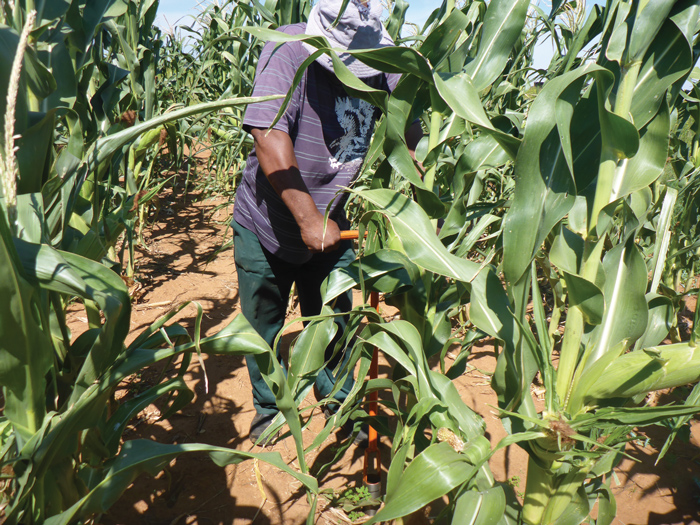
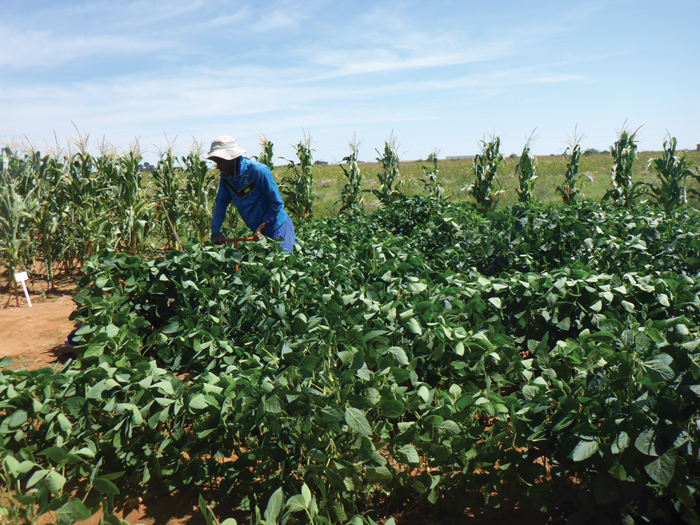
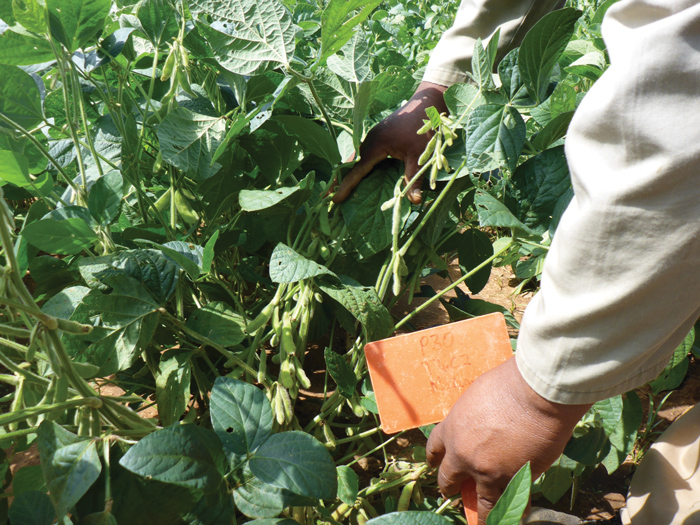
Results and discussion
During the first growing season, β-glucosidase activity was higher in soil planted to either soybean or cowpea and followed up with maize than that in soil from only maize. Alkaline phosphatase activity was better improved when maize was planted after cowpea compared to maize planted after soybean and only maize. Urease activity was not affected by rotation during this season. Low fertilisation improved β-glucosidase activity better than high fertilisation. Alkaline phosphate and urease activities were not affected by fertilisation.
During the second growing season, urease activity was higher in soil planted to either soybean or cowpea and followed up with maize than that in soil from only maize. Both β-glucosidase and alkaline phosphatase were not affected by rotation during this season. The low fertilisation improved β-glucosidase, urease and alkaline phosphate activity more than the high fertilisation.
Generally, rotation of maize with legumes improved enzyme activity better than that in systems that contained only maize. Cowpea and soybean have a low C:N ratio, which can increase enzyme activity. The residual N of the soybean was very low because this crop has a high nitrogen harvest index. However, the yield obtained from the maize that was planted after soybean was higher than that obtained from maize that was preceded by maize.
These observations indicate that legumes benefit a subsequent cereal crop not only with residual N, but also with other non-N effects such as improved microbial and enzyme activities. In addition, the variety of plant families such as legumes and cereals, promote diversification of plant root systems that favour enzyme activity. A system that contains only maize could always be linked to lower enzyme activities, which confirms the negative impact of monocropping on soil enzymes and other microbial activity. A legume-maize rotation implemented with a low fertiliser level showed more effective nutrient usage and soil microbial functions. This is a good system to improve nutrient uptake by crops to achieve higher yields.
Conclusion
Producers can improve their soil enzyme activity by including legumes in their maize cropping systems. The inclusion of legumes promotes soil processes that make nutrients available to crops even at low fertiliser levels. It is also vital for producers to monitor the pH levels of their soils, because it has a direct impact on enzyme activity. Seasonal climatic fluctuations can play a key role in the effect of rotation and fertilisation on enzyme activities. However, observations obtained from this study should be investigated further.
For further information, contact Edzisani Nemadodzi at nemadodzie@arc.agric.za.
 References
References
- Dick, RP, Breakwell, DP & Turco, RF. 1996. Soil enzyme activities and biodiversity measurements as integrative microbiological indicators. In: Methods for Assessing Soil Quality. Soil Science Society of America, Madison, WI, USA. Pp. 247 – 272.
- Nel, AA. 2005. Crop rotation in the summer rainfall area of South Africa. South African Journal of Plant and Soil, 22:4, 274 – 278.
- Vukicevich, E, Lowery, T, Bowen, P, Úrbez-Torres, JR & Hart, M. 2016. Cover crops to increase soil microbial diversity and mitigate decline in perennial agriculture. A review. Agron. Sustain. Dev., 36: 48.
- Wang, X-Y, Ge, Y & Wang, J. 2017. Positive effects of plant diversity on soil microbial biomass and activity are associated with more root biomass production. J Pl Interact., 12:533 – 541.
- Wožniak, A. 2019. Chemical properties and enzyme activity of soil as affected by tillage system and previous crop. Agriculture, 9: 262.










